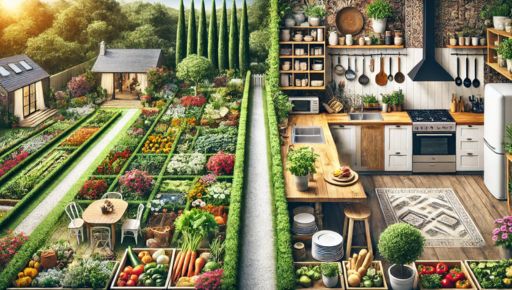When it comes to designing a home, the kitchen is often the heart of the house. It’s not just where meals are prepared, but also where families gather, entertain guests, and create lasting memories. The style and layout of your kitchen play a vital role in enhancing the functionality and aesthetics of this important space. In this article, we’ll explore various kitchen types, helping you choose the best one for your home and lifestyle.
Understanding Kitchen Types: An Overview
A kitchen isn’t just a one-size-fits-all room. There are several kitchen types designed to suit different needs, available space, and personal preferences. Whether you’re an avid chef or someone who enjoys casual cooking, understanding the layout of a kitchen can make a significant difference in the overall functionality and comfort. Let’s dive into the most popular kitchen types to help you make an informed decision.
1. The Galley Kitchen: Perfect for Small Spaces
One of the most efficient kitchen types for compact areas is the galley kitchen. Often referred to as a “workhorse” kitchen, it features two parallel countertops that form a corridor. This design maximizes space and minimizes unnecessary movement, which is ideal for smaller kitchens. The galley kitchen is commonly found in apartments or homes with limited square footage.
Pros of the Galley Kitchen:
- Highly functional with everything within reach
- Works well for one or two people cooking at a time
- Easy to maintain and clean due to its efficient layout
Cons of the Galley Kitchen:
- Can feel cramped, especially in high-traffic homes
- Limited counter space for larger cooking tasks
- Lack of storage or prep space in some designs
2. The L-Shaped Kitchen: Flexible and Versatile
The L-shaped kitchen is one of the most versatile kitchen types. It features two countertops arranged at a right angle, forming an “L” shape. This layout is ideal for medium to large-sized kitchens and works well in both open-concept homes and those with closed-off spaces.
Pros of the L-Shaped Kitchen:
- Provides ample counter space and storage
- Allows for a smooth workflow with a clear division of areas
- Suitable for families and those who like to entertain guests
Cons of the L-Shaped Kitchen:
- Can result in unused space if not designed well
- Limited counter space if the layout is not optimized
3. The U-Shaped Kitchen: Ideal for Families and Larger Spaces
The U-shaped kitchen is designed with countertops on three sides, creating a U-shape. This layout is often favored in larger kitchens, as it offers plenty of space for cooking, prepping, and entertaining. The U-shaped kitchen creates an efficient work triangle, ensuring that everything is within reach.
Pros of the U-Shaped Kitchen:
- Excellent for families or those who cook frequently
- Plenty of storage and counter space
- Helps organize the kitchen into specific zones for tasks
Cons of the U-Shaped Kitchen:
- May feel closed off in smaller spaces
- Requires a significant amount of square footage to avoid feeling cramped
4. The Island Kitchen: A Central Hub for Cooking and Socializing
Island kitchens are all about incorporating a central feature—a large, movable island—into the design. This type of kitchen often works well in open-concept homes, where the kitchen is part of a larger living area. The island can be used for a variety of purposes, from meal prep to casual dining and even socializing.
Pros of the Island Kitchen:
- Offers extra counter space and storage
- Functions as a multi-purpose area for cooking, dining, and entertaining
- A visually appealing feature in an open-plan space
Cons of the Island Kitchen:
- Requires a spacious kitchen to accommodate an island without crowding
- Can be expensive to install and maintain
5. The Peninsula Kitchen: A Space-Saving Alternative to the Island
If you love the idea of an island kitchen but don’t have the space for a full island, the peninsula kitchen might be the perfect solution. This layout features a countertop that extends from one side of the kitchen, creating a “peninsula” that can serve as an additional prep area, breakfast bar, or seating area.
Pros of the Peninsula Kitchen:
- Provides similar benefits to an island kitchen, but in a more compact form
- Ideal for kitchens with limited space or narrower layouts
- Allows for easy flow and movement in smaller kitchens
Cons of the Peninsula Kitchen:
- Limited workspace compared to an island
- Can create traffic flow issues in tighter spaces
6. The Open Kitchen: Embracing Modern Living
The open kitchen is one of the most popular kitchen types in modern homes. It features a layout that seamlessly integrates the kitchen into the living or dining area, eliminating walls or barriers between the spaces. This layout is perfect for those who enjoy entertaining, as it allows the cook to remain connected with guests while preparing meals.
Pros of the Open Kitchen:
- Promotes a social atmosphere by keeping the cook engaged with guests
- Makes the kitchen feel larger and more inviting
- Great for homes with a modern or minimalist aesthetic
Cons of the Open Kitchen:
- Can create noise and mess in living areas
- Lack of privacy, especially if the kitchen is cluttered
- May require more maintenance to keep the space tidy
7. The Farmhouse Kitchen: Traditional and Charming
For those who appreciate rustic charm and traditional design, the farmhouse kitchen is a timeless option. This layout often incorporates natural materials like wood and stone, as well as vintage or industrial elements. A farmhouse kitchen typically features an open layout, large countertops, and plenty of storage.
Pros of the Farmhouse Kitchen:
- Warm and welcoming, ideal for families
- Offers ample storage and counter space
- Easily customizable to fit your style
Cons of the Farmhouse Kitchen:
- Can require more maintenance due to the materials used
- May not be suited for smaller or more modern homes
8. The Modern Kitchen: Sleek and Streamlined
Modern kitchens focus on clean lines, minimalist design, and cutting-edge appliances. These kitchens typically feature high-tech gadgets, smart storage solutions, and sophisticated materials like stainless steel, glass, and stone. Modern kitchens are great for those who appreciate contemporary aesthetics and value efficiency.
Pros of the Modern Kitchen:
- Streamlined and functional design
- Often incorporates high-end appliances and storage solutions
- Easy to clean and maintain due to the minimalist approach
Cons of the Modern Kitchen:
- Can feel cold or impersonal if not carefully styled
- Requires regular updates to keep up with the latest trends and technologies
Conclusion: Choosing the Right Kitchen Type for Your Home
The kitchen type you choose will depend on your cooking habits, the amount of space available, and your design preferences. Each layout offers its own set of benefits and potential challenges, but with the right planning, you can create a kitchen that enhances both form and function in your home. Whether you opt for a galley kitchen, an island layout, or a farmhouse design, make sure it suits your lifestyle and meets your needs.
By understanding the different kitchen types, you can design a space that complements your home and makes cooking an enjoyable experience. Start by assessing your kitchen’s size, your family’s cooking habits, and your overall aesthetic preferences, and choose a layout that works best for you!

